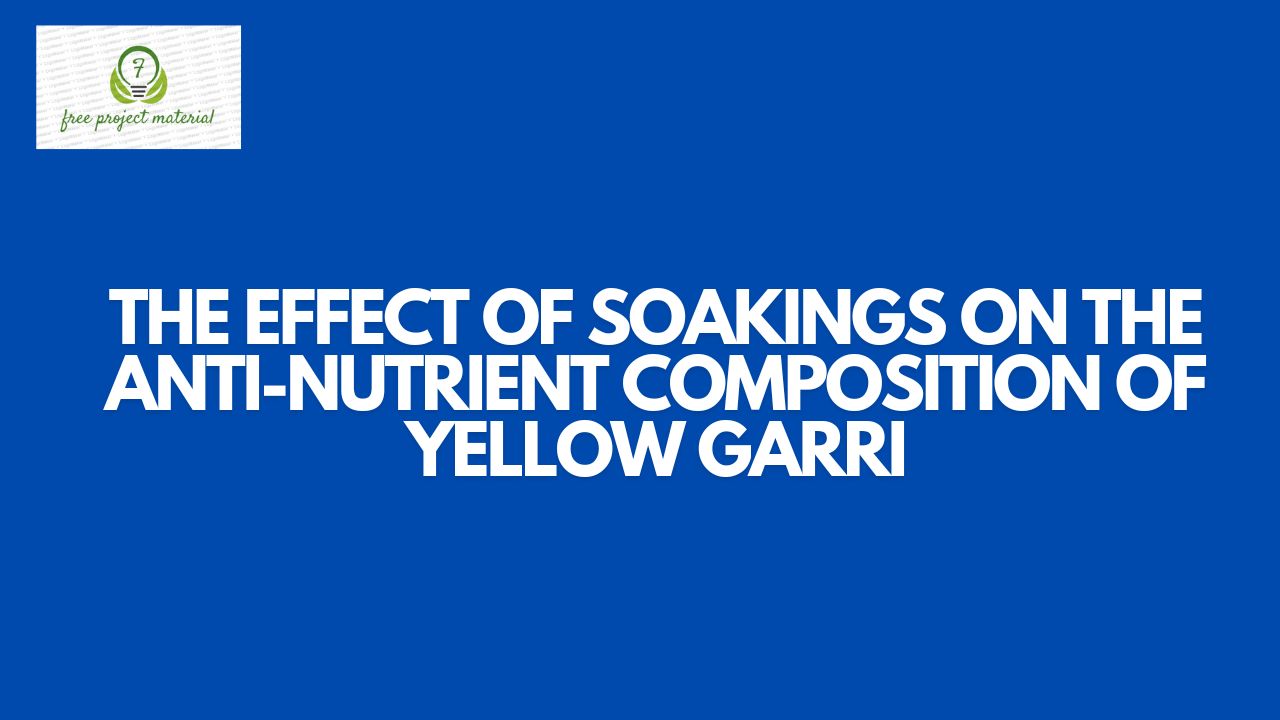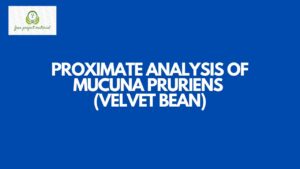ABSTRACT
This study on the effect of soaking on the antinutrient composition of yellow garri was carried out using standard analytical methods. The result of the study revealed the following: HCN (1.528±0.038 mg/100g), Phytate (0.313±0.018 mg/100g), Tannins (0.762±0.015 mg/100g) and Oxalate (1.030±0.04 mg/100g) for soaked garri while unsoaked had HCN (3.46±0.070), Phytate (0.446±0.015 mg/100g), Tannins (0.674±0.016 mg/100) and oxalates (1.901±0.014 mg/100g). The concentrations of the antinutrient were below the lethal dose in both samples. Which implies that the garri is safe for consumption and is devoid of toxic amount of antinutrients. Therefore, it is recommended that consumption of dry garri should be in moderate quantity since it contains higher amount of antinutritional factors.
TABLE OF CONTENT
Tile page- – – – – – – – – i
Certification – – – – – – – – ii
Dedication – – – – – – – – – iii
Acknowledgements- – – – – – – vi
Abstract- – – – – – – – – v
Table of Contents- – – – – – – – vi-vii
CHAPTER ONE: INTRODUCTION
1.1 Background of the Study- – – – – – 1
1.2 Aim and objective of the study – – – – – 5
1.3 Scope and Limitation of the study – – – – – 5
CHAPTER TWO: LITERATURE REVIEW
2.1 Processing Techniques of cassava Roots into Garri- – 6
2.2 Challenges Facing Garri production – – – – – 9
2.3 Prospects Garri processing Technologies- – – – 11
2.4 Antinutritional factors- – – – – – – 14
2.4.1 Tannins – – – – – – – – – 14
2.4.2 Phytates – – – – – – – – – 15
2.4.3 Oxalates – – – – – – – – – 16
2.4.4 Goitrogens – – – – – – – – 17
2.4.5 Saponin – – – – – – – – – 18
2.5 Method for Disabling Antinutrients – – – – – 18
2.5.1 Soaking- – – – – – – – – 18
2.5.2 Fermentation- – – – – – – – 19
CHAPTER THREE: MATERIALS AND METHOD
3.1 Materials- – – – – – – – – 21
3.2 Method- – – – – – – – – 21
3.2.1 Sample collection and preparation- – – – – 21
3.2.2 Sample Digestion – – – – – – – 22
3.2.3 Determination of Anti nutrient – – – – – – 22
CHAPTER FOUR: RESULT AND DISCUSSION
4.1 Results- – – – – – – – – 26
4.2 Discussion – – – – – – – – 27
CHAPTER FIVE: CONCLUSION AND RECOMMENDATIONS
5.1 Conclusion- – – – – – – – – 30
5.2 Recommendations – – – – – – – 30
References
CHAPTER ONE
1.0 INTRODUCTION
1.1 Background of the Study
Cassava (Manihot esculenta cranz) is a woody shrub native to south America of the spurge family, Euphorblaceae (Zagrobelny et al., 2004). It is extensively cultivated as an annual crop in tropical and subtropical region for its edible starchy tuberous root, a major source of carbohydrates (Lunsin et al., 2012). Cassava is the third largest source of food carbohydrate in the tropics, after rice and maize. It is a major staple food in the developing world, providing a basic diet for over half a billion people (Oziedzoave et al., 2006). It is one of the most drought tolerant crops, capable of growing on marginal soils. In 2014, global production of cassava root was 268 million tonnes, with Nigeria as the world’s largest producer of nearly 55 million tonnes or 21% of the world total (Conyne et al., 2006).
Cassava is classifies as either sweet (Manihot palmat) or bitter (Manihot esculenta or Manihot utilissima). Like other roots and tubers, both bitter and sweet varieties of cassava contain anti-nutritional factors and toxins with the bitter varieties containing much larger amounts (Sanni et al., 2007). It must be properly prepared before consumption, as improper preparation of cassava can leave enough residual cyanide to cause acute cyanide intoxication, goiters and even ataxia, partial paralysis, or death (Pope et al., 2001). The more toxic varieties of cassava are a fall-back resources (a “food security crop”) in times of famine or food insecurity in some places. Farmers often prefer the buter varieties because they deter pests animals, and thieves (Linley et al., 2002).
In Nigeria, as in most African countries, cassava is one of the most important carbohydrate sources. About 95 percent of cassava is consumed as food and less than 5 percent of it is used for industrial purposes (Awoyinka 2009). It is usually consumed in processed forms. In recent times, several processing options have emerged from cassava such as garri, fufu, starch, flour, topiaca and chips. Irrespective of these options, garri (roasted granules) and edible starch (which is a by- product from dry and grated tubers) have maintained an important position in the food time table of many households in Nigeria and other countries of the worlds although starch consumption is most notable in the south-south region of Nigeria (Erhabor et al., 2007). Toxicity of cyanide in cassava products has been reported. There are as well few reported cases of death lined to consumption of cassava meals (Sanni and Jaji, 2013). The incidents of cassava toxicity parallel severe hunger condition associated with drought or wartime when processors adopt “shortcut” (shortened process time) in order to meet market demand. Consumption of garri has always been a trend in Nigeria and some other parts of the world. The consumption of this product has been accompanied with some side effects like food poisoning and other related effects due to inefficiency in the course of production, which inevitably leads to improperly processed product and when this product is consumed, it results to food poisoning and its effect can be fatal (Sanni and Jaji, 2013). On 20th March 1994, one Mrs. Loveth Osueke was reported in the National dailies to have died after eating African salad made from cassava which she bought fromAriaria market in Aba, Abia State, Nigeria. More recently, it was also reported in the national dailies on Tuesday 1st Novermber 2016 that six persons (including a mother, her three children and her two neigbours) died after consumption of cassava product (“Lafun”) in ogaminana area of okene in Kogi state Nigeria (Odogun 2016).
Ferment action is an important processing technique for cassava, especially in Africa. Three major types of fermentation of cassava roots are recognized. The grated root fermentation, fermentation of roots under water and mould fermentation of roots in heaps (Westby 2002). The grated cassava roots are allowed to ferment in sacks for 3-7 days, which encourages lactic acid fermentation. The pH after 3 days decreases from 6 to 4 and the fermentation is dominated by lactic acid bacteria (Sanni et al., 2007). Grating is important for bringing linamarin into contact with linamarase allowing its hydrolysis to glucose and cyanohydrin and then to HCN (Shepherd et al., 2010). The continues during the fermentation process. Lactic acid fermented products are reported to have significant concentrations of cyanohydrin is stable at low PH. The processes of garri production reduce cyanogen contents by more than 95% (Westby, 2002). Fermentation of cassava roots under water, followed by sun drying, is reported to be the best for fro cyanogens removal (Cardoso at al., 2005). This type of fermentation is used more in areas where there is a sufficient supply of water such as near a river or lake, and is common in countries such as Nigeria, Democratic Republic of Congo, Tanzania and Malawi (Wetby, 2002).
1.2 Aim and Objective of the Study
The aim of this study is to determine the effect of soaking on the anti-nutrient composition of yellow garri.
The objective of these studies are as follows
- To determine the anti-nutrient composition of soaked yellow garri
- To determine the anti-nutrient composition of unsoaked yellow garri
- To compare the anti- nutritional composition of soaked and unsoaked yellow garri
- To make useful recommendation base on the reunite of the study
1.3 Scope and Limitation of the Study
Theses study focus on the effect of soaking on the anti-nutrient composition of yellow garri. This study is limited due to time and financial constraints.



